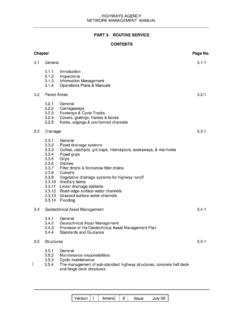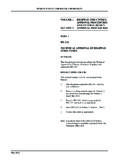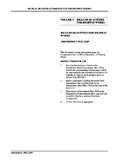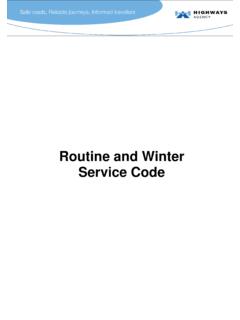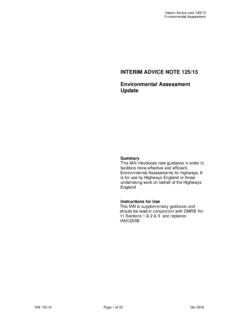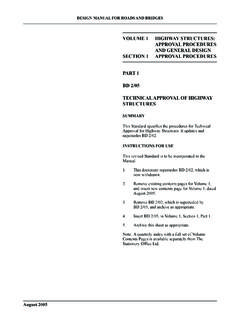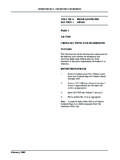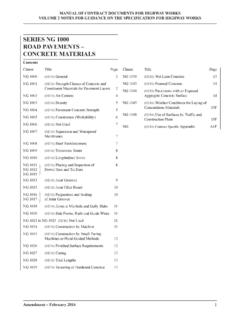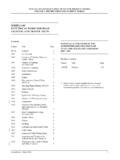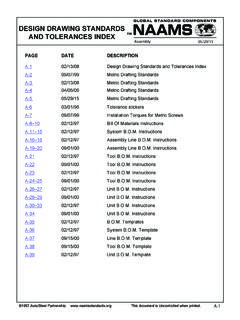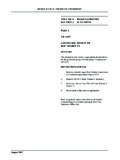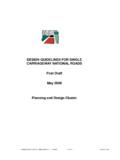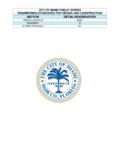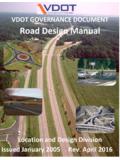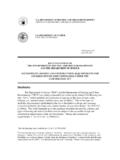Transcription of TA 90/05 - Standards for Highways
1 February 2005 design MANUAL FOR ROADS AND BRIDGESVOLUME 6 ROAD GEOMETRYSECTION 3 HIGHWAY FEATURESPART 5TA 90/05 THE geometric design OFPEDESTRIAN, cycle ANDEQUESTRIAN ROUTESSUMMARYThis Advice Note provides guidance on the geometricdesign for NMU off-carriageway routes associated withtrunk road or motorway improvement FOR USEThis is a new document to be inserted into the Contents pages from Volume new Contents page for Volume 5 datedFebruary TA 90/05 into Volume 6, Section archive this sheet as : A quarterly index with a full set of VolumeContents Pages is available separately from TheStationery Office Ltd.
2 TA 90/05 The geometric design ofPedestrian, cycle andEquestrian RoutesSummary:This Advice Note provides guidance on the geometric design for NMUoff-carriageway routes associated with trunk road or motorway MANUAL FOR ROADS AND BRIDGESTHE Highways AGENCYSCOTTISH EXECUTIVEWELSH ASSEMBLY GOVERNMENTLLYWODRAETH CYNULLIAD CYMRUTHE DEPARTMENT FOR REGIONAL DEVELOPMENTNORTHERN IRELANDV olume 6 Section 3 Part 5 TA 90/05 February 2005 REGISTRATION OF AMENDMENTSA mendPage NoSignature & Date ofAmendPage NoSignature & Date ofNoincorporation ofNoincorporation ofamendmentsamendmentsRegistration of AmendmentsVolume 6 Section 3 Part 5 TA 90/05
3 February 2005 REGISTRATION OF AMENDMENTSA mendPage NoSignature & Date ofAmendPage NoSignature & Date ofNoincorporation ofNoincorporation ofamendmentsamendmentsRegistration of AmendmentsVOLUME 6 ROAD GEOMETRYSECTION 3 HIGHWAY FEATURESPART 5TA 90/05 THE geometric design OFPEDESTRIAN, cycle ANDEQUESTRIAN MANUAL FOR ROADS AND BRIDGESF ebruary 2005 Volume 6 Section 3 Part 5 TA 90/05 February 20051/1 Chapter 1 Introduction1. variety of guidance exists on aspects ofdesigning for non-motorised users (NMUs). NMUs areconsidered to be pedestrians, cyclists or consideration needs to be given to the needsof disabled people, who may use any of these Advice Note provides guidance on thegeometric design for NMU off-carriageway routesassociated with trunk road or motorway improvementschemes.
4 The advice is also relevant for NMU routesaway from trunk roads constructed as part of a trunkroad improvement, and for aspects of crossing the trunkroad not dealt with in BD 29 (DMRB ), TD 36(DMRB ) or TD 50 (DMRB ). For generaladvice covering on-carriageway routes, designersshould refer to cycle Friendly Infrastructure (IHT,1996), the Traffic Signs Manual Chapter 5 (DfT, 2003)and other Advice Note does not cover issues of routechoice, scheme assessment, signing, or more generalaspects of designing for NMUs. These are covered inTA 91 (DMRB ), which should be referred to inconjunction with this document.
5 Designers are alsoreferred to HD 42 (DMRB ), which sets outprocedures for ensuring that scheme designs haveconsidered the needs of Advice Note and those identified abovewholly supersede TA 67 (DMRB ) and Chapters 8and 11 of TA 57 (DMRB ). the purpose of this Advice Note, users ofelectrically assisted pedal cycles or poweredwheelchairs and invalid carriages, that conform withcurrent Department for Transport Regulations and maylegally be used on pedestrian and cycle facilities, arealso considered as NMUs. Where there is known to beregular use of these vehicles, design parameters forcyclists should be with all highway design , there is a need tobalance issues of safety and practicality.
6 This AdviceNote provides preferred and acceptable minimumvalues based on best available evidence, but inexceptional circumstances it may be appropriate toapply some flexibility in using these figures over shortdistances and where other measures are used such as SLOW markings to encourage lower Advice Note should be used forthwith on allschemes for the construction, improvement andmaintenance of trunk roads currently being preparedprovided that, in the opinion of the OverseeingOrganisation, this would not result in significantadditional expense or delay progress.
7 DesignOrganisations should confirm its application toparticular schemes with the Overseeing this is confirmed, the contract documents for theWorks should be written to reference this Advice Advice Note does not apply in following definitions have been used withinthis document: a shared use route is an unsegregated facilityused by more than one type of NMU, forexample pedestrians and cyclists or pedestrians,cyclists and equestrians; an adjacent use route is one with clearly definedsegregated areas for different types of may be by white line or by aphysical feature such as a verge, a fence or akerbed level 6 Section 3 Part 5 TA 90/05 February 20052/1 Chapter 2 design Speed2.
8 design designing facilities for pedestrian -only use, itis not necessary to consider design speed. However, it isimportant in designing facilities for use by cyclists andequestrians, as it affects other design parameters suchas speeds for cyclists can vary according todifferent types of user. The design cyclist types are: fast commuter; other utility cyclist; inexperienced utility cyclist (may travel moreslowly than regular cyclists); child; and users of specialised authorities in the UK and overseas haveused a range of design speeds, from 10 kph to 50 , cyclists travelling in excess of 30 kph are lesslikely to be using off-carriageway design speed of 30 kph should be adopted formost off-carriageway cycle routes.
9 However, where acyclist would expect to slow down ( on the approachto a crossing or a subway) the design speed may bereduced to 10 kph over short distances, with use of SLOW design speeds appropriate for different routetypes are summarised in Table minimum (over short10 kphdistances)General off-carriageway cycle route30 kphprovisionTable design Speed for Off-CarriagewayCycle concept of design speed for equestrians isunusual, as there are different speeds at which horsesprogress, depending upon the type of activity beingundertaken (such as leisure or fitness training) and thesurrounding are three basic speeds of travel: walk, trotand canter.
10 The speed is particularly affected by routesurface. Grass and wood chip bark can provideadequate surfaces for cantering, whereas routessurfaced with bituminous materials are generallydiscouraged and would only make walking or a slowtrot possible. In areas close to motorised traffic, horsesmay be walking, or occasionally trotting briskly, tominimise the time spent by a busy and show design speeds fordifferent circumstances. In Table remote fromcarriageway means that the road is either: generally not visible due to screening or planting;or visible, but more than 6m from the to carriagewayWalkOn approach to crossingWalkRemote from carriagewayWalk(for <50m length)Remote from carriagewayTrot/Canter(for > 50m length)Table Expected Speeds for Equestrian RoutesVolume 6 Section 3 Part 5 TA 90/05 February 20052/2 Chapter 2 design SpeedType of UseDesignSpeedTrot/Canter20 kphWalk10 kphTable design Speeds for Equestrian RoutesShared routes are shared with other users, thedesign speed of these routes should be relevant to thatof the fastest user (see Table ).
